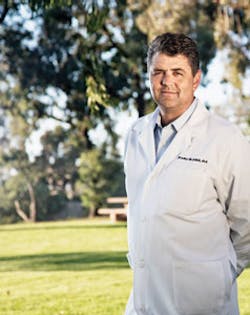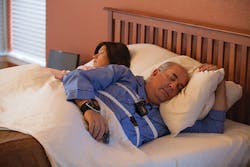Sleep apnea dentistry: A dental opportunity
Sleep apnea dentistry, or "sleep dental medicine," is routinely referred to as the greatest opportunity for dentistry since tooth whitening. I generally agree with this assessment, but with an important caveat: The opportunity for general dentists that comes from the addition of sleep apnea dentistry is the additional dental care needed for the management of patients with sleep-disordered breathing.
It is generally assumed that the sleep apnea oral appliance is the economic engine of the sleep apnea dental practice. However, I believe the dental opportunity goes far beyond this. In fact, it may have little to do with the appliance at all.
In order to fully appreciate the opportunity, it is important to realize that treating sleep patients is a medical procedure provided for a medical condition. It is therefore billed under medical insurance. If you are not interested or are philosophically opposed to billing medical insurance, then it would be best for you to stop reading now.
The effects on the dentition and periodontium from treatment for sleep-disordered breathing are well known. Even so, sleep patients often struggle to find dental teams trained in sleep apnea dentistry who can accommodate their unique needs. Patients who are happily treated with continuous positive airway pressure (CPAP) require additional oversight and dental follow-up to manage the effects of CPAP on the oral cavity. These patients require additional hygiene visits and, at minimum, an annual follow-up focused on their sleep condition. The appointment includes a medical history to document any changes, with appropriate dental comments on any needs for therapeutic modification.
Identifying patients who are being treated or need to be treated for sleep disorders is a critical component of sleep apnea dentistry. Intake questionnaires such as the Epworth Sleepiness Scale (ESS) or STOP-BANG assessment are critical to initiate discussions about sleep quality. Sleep screening questionnaires have been validated to identify patients who may be at risk for sleep apnea.
Sleep apnea dentistry also requires an educated and engaged clinical team. Effective team communication is as much the arbiter of success in sleep apnea dentistry as it is in periodontal and cosmetic programs. Team education before handing out sleep apnea questionnaires is vital to assure communication is presented with confidence.
After an at-risk patient has been identified, the next step is the diagnosis. The dentist must decide whether to recommend a lab polysomnogram (PSG) or a home sleep test with a portable sleep monitor (PSM/PM). This is a medical condition, and the diagnostic choice is determined in large part by the requirements to make a differential diagnosis. You must ask yourself, "What test is needed to provide the data that will allow the interpreting physician to make a single diagnosis, which then will determine the most appropriate treatment?"
Sleep apnea dentistry is no different than other specialties in this regard. For example, when determining periodontal treatment, we ask, "What are the tests required to provide an accurate periodontal diagnosis and therefore a proper determination of care?" No periodontal program is started with a single test result. Instead, a number of data points are required to obtain a diagnosis upon which a care plan is developed.
Portable sleep monitors that diagnose sleep apnea in the home are generally level III devices, which means they have four to seven channels. Some full-featured devices have as many as 18 channels. It is important to note that not all systems are created equal. Aileen Love, MD, and Samuel Kuna, MD, make this point in an article I recommend from the Journal of Dental Sleep Medicine. They observe that "direct comparison studies between in-lab PSG and PMs are fraught with complications, primarily because differences in equipment and testing environments can significantly influence results."1
Portable sleep monitor devices used in sleep apnea dentistry should have as many channels as possible to meet the standards of an attended PSG. It is also important to understand that the needs of the dentist using a portable sleep monitor to calibrate an oral appliance go well beyond simply monitoring the apnea/hypopnea index (AHI). Parameters such as body position, electromyogram (EMG) for sleep bruxism monitoring, and abdominal as well as thoracic belts to distinguish central from obstructive sleep apnea are all important. They are not necessarily a part of all portable sleep monitors.
Another often overlooked component of sleep apnea dentistry is the requirement for a physician to participate in the care of the patient. This is a requirement for a number of reasons. In my opinion, the most important contribution by the physician is the elimination of the 100-plus sleep disorder complications to be considered when I am managing the patient's sleep-disordered breathing.
Sleep study using NOX T3 portable sleep monitor (CareFusion)
In my practice, we use a portable sleep monitor and a local board-certified sleep physician to interpret our studies. The physician provides prescriptions for those cases that require oral appliances. Again, Drs. Love and Kuna are instructive on this point: "Dental practices performing [home sleep tests] to help titrate [oral appliances] to an effective fit tend to use PM systems that provide automated scoring. There is no evidence to strongly support or discourage this practice, although, results of automated scoring should be interpreted with caution and patients should follow-up with their sleep physician once the appliance's final fit has been established."1
Dentistry is uniquely positioned to be the single greatest asset to the sleep community by providing a method for monitoring, reporting, and helping patients maintain a care plan that is consistently updated for maximum effectiveness. Many of the current sleep dentistry training programs suggest that an office identify a patient at risk, test with a single technique, and launch into treatment. However, this approach provides little of the true value that we have to add to our patients' health and well-being. In our office, we have found that once our referring doctors understand our comprehensive disease management plan for sleep-disordered breathing, they become our best referral sources.
In the end, we are doctors. We are expected to act accordingly. Sleep is not part of most dental education programs. One must simply remember how much time and education was required to obtain an accurate diagnosis for any one of the many dental conditions we treat. We should remember the number of data points we require to make an accurate diagnosis and develop an appropriate treatment plan, as well as the skill level required to monitor treatment. This includes the modifications along the way that are required to obtain the desired outcome.
When we consider this, it is easy to see that "sleep dentistry" may be more complex than that weekend course would lead us to believe. This is in no way meant to discourage you from adding this service to your office, as there are thousands of patients who can use your help. I would guess that you saw at least three patients this week who could use the expanded services you would provide if you had a sleep apnea diagnosis. However, when you add this to your repertoire, do so with the same level of commitment, skill, and training that you would expect a physician to have in order to add a perio program to the list of his or her services.
Reference
1. Love AL, Kuna ST. Home sleep testing and sleep apnea: A review for dentists. Journal of Dental Sleep Medicine. 2016;3(3)45-52.
Bradley Eli, DMD, MS, is a specialist in orofacial pain and sleep. He is an educator, consultant, and inventor, expanding the scope of health-care practice by creating previously unavailable services. He patented QuickSplint, a device used to immediately address jaw and muscle sprain strain injury (JAMSS). He can be reached at [email protected].

